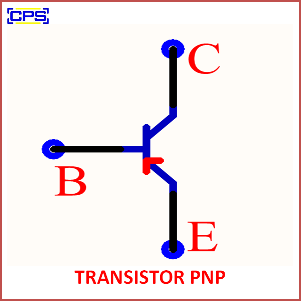A PNP Transistor is a type of bipolar junction transistor (BJT) where the arrangement of semiconductor materials consists of a n-type layer sandwiched between two p-type layers. The PNP transistor operates in a similar manner to the NPN transistor but with reversed polarity and current flow.

Key Features of a PNP Transistor:
- Three Regions:
- Emitter (E): The region that emits holes (p-type material).
- Base (B): The central region that controls the flow of holes (n-type material).
- Collector (C): The region that collects holes (p-type material).
- Current Flow:
- Forward Active Mode (Amplification): When the base-emitter junction is forward biased (negative voltage applied to the base relative to the emitter), holes flow from the emitter to the base and are collected by the collector, allowing a small base current to control a larger collector current.
- Amplification:
- A PNP transistor amplifies the small current at the base to produce a larger output current at the collector, similar to the NPN transistor, but with the current direction reversed.
Working Principle:
- When a small current flows from the emitter to the base (in the case of PNP, holes are injected), it allows a larger current to flow from the collector to the emitter.
- Base-emitter Junction (Forward Bias): For the transistor to operate, a small current (of holes) flows from the emitter to the base, which allows a much larger current to flow from the collector to the emitter.
- Collector-emitter Junction (Reverse Bias): The transistor operates as an amplifier or switch by controlling the collector current with the base current.
Applications of PNP Transistors:
- Switching Circuits:
- Used to control the flow of current in various applications like switching on or off electrical devices.
- Amplifiers:
- Used in audio, radio frequency, and signal amplification circuits.
- Voltage Regulators:
- Can be used in voltage regulation circuits due to their ability to handle higher voltages.
- Analog Signal Processing:
- Amplifies or modifies analog signals in audio and communication systems.
Advantages:
- High Current Gain: Like NPN transistors, PNP transistors provide significant amplification of a small input current.
- Good Switching Speed: Ideal for applications requiring fast switching.
- Widely Used: Common in complementary push-pull amplifiers and other circuits where both NPN and PNP transistors are needed.
Disadvantages:
- Requires Proper Biasing: Like NPN transistors, PNP transistors need correct biasing to operate effectively.
- Temperature Sensitivity: Their performance can degrade with changes in temperature, especially in high-power applications.
